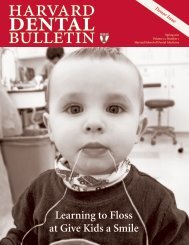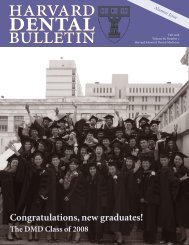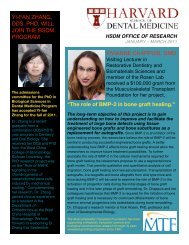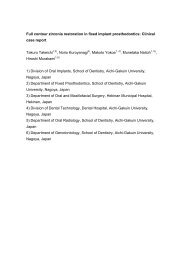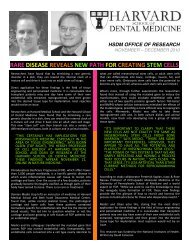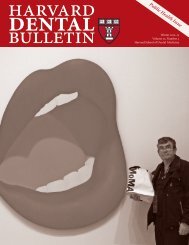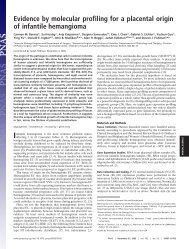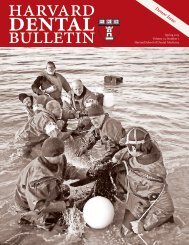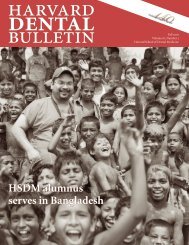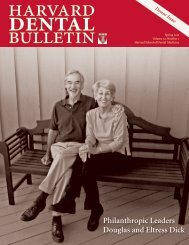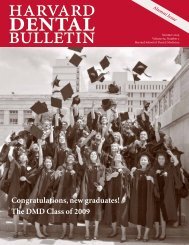Research Issue - Harvard School of Dental Medicine
Research Issue - Harvard School of Dental Medicine
Research Issue - Harvard School of Dental Medicine
Create successful ePaper yourself
Turn your PDF publications into a flip-book with our unique Google optimized e-Paper software.
harvarddentalbulletinWinter 2010–11Volume 70Number 3Alumni FocusClass <strong>of</strong> ’44 Members Studied Together,Went to War TogetherBob Hennessy and Phil Sehl have kept in touch for 70 years.They came as dental students and left as <strong>of</strong>ficers in theUS Navy. Bob Hennessy and Phil Sehl, both Class <strong>of</strong> 1944, wereamong 40 men training to be dentists at the <strong>Harvard</strong> <strong>School</strong><strong>of</strong> <strong>Dental</strong> <strong>Medicine</strong> during World War II. “Before the UnitedStates entered the war,” says Sehl, “when we were first-yearsat HSDM, people were being drafted. To avoid the draft andto stay in school, most <strong>of</strong> us signed on with the Army or theNavy to serve when we finished at the <strong>School</strong>. When we got ourdiplomas, we—including the medical students—were givenour first commission for military service.”In fact, the students received their diplomas at the <strong>School</strong>, thenwent across to Vanderbilt Hall for a commissioning ceremony,which included music from a Navy band. “That was March 20,1944,” says Sehl. “We received our commissions as lieutenantjunior grade and got our service assignments.” Of the 38 menwho graduated in the DMD Class <strong>of</strong> 1944, 32 went straight intomilitary service, with 16 choosing the Navy and 16 the Army.the warIn December 1941, when Hennessy and Sehl and the rest <strong>of</strong>the Class <strong>of</strong> ’44 were still new at HSDM, the Empire <strong>of</strong> Japanattacked the US naval base at Pearl Harbor, Hawaii—leading tothe US declaration <strong>of</strong> war on Japan. “A lot <strong>of</strong> us tried to breakour commissions so we could join the war effort right away,”says Sehl. “But we couldn’t; we had to finish our dental training.They needed dentists.” Indeed they did. Four <strong>of</strong> the 16 menfrom <strong>Harvard</strong> who went into the Navy—including Hennessyand Sehl—were sent to the Sampson Naval Training Center atLake Seneca, N.Y. There they were among some 200 dentistscharged with treating 50,000 recruits—most <strong>of</strong> whom hadnever before seen a dentist—to ensure that they were healthyand ready to be deployed within six weeks.Hennessy and Sehl shared an apartment in the <strong>of</strong>ficers quarterson the base. They received little naval training, functioning solelyas dentists to the recruits. But after some time, both decidedthey no longer wished to stay at Sampson. They sentletters to “big shots” in the Navy whom they knew,asking to be sent to the war itself. Hennessy, whohails from Westborough, Mass., knew Admiral LouisDenfeld, chief <strong>of</strong> the Bureau <strong>of</strong> Naval Personnel, whowas also from Westborough. “I wrote to him andtold him I wanted to go to sea. Within two weeks,I was assigned to USS Starlight, a troop-transportship.” Hennessy was told to report to San Franciscoto wait for further orders; that journey to the WestCoast was his first trip on an airplane.Waiting in San Francisco for five weeks, Hennessyand a friend stayed at the Plaza Hotel, where theBob Hennessy, DMD ’44, today, at his home inWestborough, Mass.2
alumni fo cus“What I have is due to what <strong>Harvard</strong> <strong>Dental</strong> <strong>School</strong> did for me. As a <strong>Harvard</strong> dentist,I was able to meet people, make the right connections, and earn a good living.”—Bob Hennessy, DMD ’44Navy had taken some rooms, and toured around the city. Flushwith extra per-diem pay, they made it a point never to eat at thesame restaurant twice, Hennessy remembers.One night, he was told to report to the airport; he was to be takento his ship. “I got on the plane, and we took <strong>of</strong>f out into the darkness,going I knew not where,” he remembers. “In the morning, Ilooked out and saw an island. When we landed, the door openedand a girl said, ‘Welcome to Hawaii.’ There were s<strong>of</strong>t smells andmuted noises <strong>of</strong> the birds; it was quite an interesting first view<strong>of</strong> Hawaii.” As Starlight was not scheduled to arrive for anotherthree weeks, Hennessy and some friends rented a Jeep and againtook the opportunity to tour the area. When the ship finallyarrived, Hennessy had to take a water taxi to reach it. “Who wasdriving the water taxi but Phil Butterfield, who lived around thecorner from me in Westborough!” marvels Hennessy. An unexpectedbut welcome encounter during wartime.States dropped an atomic bomb on the city <strong>of</strong> Nagasaki, Japan,leading to the Japanese surrender. About a month later, Sehland his group went into Japan. One day, he and some friendstook a train to Nagasaki and witnessed the devastation.after the warHennessy, meanwhile, continued to serve on Starlight. “Afterthe Japanese surrender,” he says, “we were the first ship to carrytroops into Japan for the occupation. Then we were part <strong>of</strong>the Navy’s Operation Magic Carpet that brought troops homefrom the Pacific theater.” In all, Hennessy served as a dentiston board Starlight for six years. After the war, the ship traveledwidely, to areas including Tientsin, China; Okinawa; andcontinued on next pageFor Sehl’s part, the Navy assigned him as a dentist to theMarines (his fourth choice <strong>of</strong> assignment; his first choice wasto serve on a battleship). He met his wife, Floydene, when shewas a stewardess on the airplane he took out to California inthe fall <strong>of</strong> 1944 to begin his assignment—a chance meeting thathas led to a marriage <strong>of</strong> more than 64 years, three children,and five grandchildren. Sehl spent three months in San Diegobefore shipping out to the Pacific, using this time to “learn alot <strong>of</strong> dentistry.” He served as a land-based dentist with MarineCorps Aviation in the mid-Pacific and spent the last six months<strong>of</strong> the war in Okinawa. He was stationed there when the UnitedPhil Sehl, DMD ’44, left, and classmate Bob Hennessy, DMD ’44,together in Sasebo, Japan, following the Japanese surrender. Bothmen served as dentists in the Pacific theater during World War II.Sehl, already in Japan, took a train to meet Hennessy’s ship whenit arrived in Sasebo. The two have remained in touch since theirHSDM days.3
harvarddentalbulletinWinter 2010–11Volume 70Number 3class <strong>of</strong> ’44, continuedthrough the Panama Canal. “It was the most exciting existence,”says Hennessy.Back home in Massachusetts, he trained as an orthodontist atTufts University <strong>School</strong> <strong>of</strong> <strong>Dental</strong> <strong>Medicine</strong> (<strong>Harvard</strong> did nothave an orthodontics program at the time) and then set up anorthodontics practice in Worcester, Mass. “I spent six years as aNavy dentist, most <strong>of</strong> it at sea,” Hennessy says. “Then I spent 59years as an orthodontist. When I look around me, I know thatwhat I have is due to what <strong>Harvard</strong> <strong>Dental</strong> <strong>School</strong> did for me.As a <strong>Harvard</strong> dentist, I was able to meet people, make the rightconnections, and earn a good living. I probably would not havewhat I have now had I not gone to <strong>Harvard</strong>.” A beloved figurein Westborough, in 2009 Hennessy served as grand marshal forthe town’s Veterans Day celebrations and gave a short speech.After the war, the Marines sent Sehl back to the Navy to finishout his enlistment. He served in Boston for six months, thencompleted his service treating prisoners in Portsmouth, N.H.Originally from Wethersfield, Conn.—the oldest town in thestate—Sehl returned to Wethersfield and set up his own practice,which he maintained until his retirement at age 76. At onepoint, he also served as mayor <strong>of</strong> the town.Sehl recently turned 90; Hennessy is 93. The bonds forged atHSDM and deepened in war have lasted more othan 70 years. HMembers <strong>of</strong> the HSDM Class <strong>of</strong> 1944Joseph J. Annese*Warren G. AttmoreWillard J. Bird*Joseph H. F. Bissell*Kenneth H. Bonenfant*Joseph J. CastanzaNovello Noel Cenci*William A. Chasse*Isadore Cohen*Earl B. Colvin*Roland P. Cullen*Nathan A. Estes, Jr.*Rufus J. Ferioli*Robert D. Firestone*David A. Frank*John E. Goodman*Sirak K. Gregory*Robert N. HennessyHenry D. Howe*Abraham Kaner*Henry Kaplan*James H. Maloney, Jr.*John H. Manhold, Jr.Roy L. McIntosh*Edmund J. McNally, Jr.*Richard D. Morrow*John R. Myles*David J. Oppenheim*William A. Pennine*Harold B. ReillyPhilip T. SehlEverett Shapiro*Frederick L. Smith*Morris Sweet*Harry A. Thompson*Charles H. Tozier*Edward J. Wasilewski*W. Boyd Weston* *deceasedTracking Down a ClassmateThe following is reprinted with permission from theOctober 1987 Bulletin <strong>of</strong> The Williston Northampton<strong>School</strong>. Sam Svasti was a 1936 alumnus <strong>of</strong> that preparatoryschool, which Bob Hennessy also attended. The twowere friends but after graduation went their separateways. They were quite surprised and pleased to find eachother as first-year classmates in the HSDM Class <strong>of</strong> 1944.After the Japanese attack on Pearl Harbor in 1941,however, Svasti immediately disappeared from the<strong>School</strong>. Hennessy was called to the HSDM dean’s <strong>of</strong>ficeand questioned about Svasti by the FBI. But Hennessyand his classmates never saw Svasti again. Years later,Hennessy learned what had happened to his friendthrough an obituary in the Bulletin <strong>of</strong> The WillistonNorthampton <strong>School</strong>. This account fills in the gap andsolves the mystery <strong>of</strong> Svasti’s disappearance.Mom Chow Yudhisthira SvastiSam Svasti, known in later life as His Serene HighnessPrince Yuthisvast Svasti <strong>of</strong> Thailand, died in 1986.He was the youngest brother <strong>of</strong> the late QueenRambhaibarnee, last queen <strong>of</strong> Thailand under monarchy.Mr. Svasti graduated from Cornell University and wasa student at the <strong>Harvard</strong> University <strong>School</strong> <strong>of</strong> Dentistrywhen World War II began. He joined the FreeThai Movement, and served in China and in Indiabefore secretly going back to Thailand (then calledSiam), working with the Siamese underground forces,and sending information on the Japanese military tothe O.S.S., predecessor <strong>of</strong> the CIA. Mr. Svasti receivedBulletins and correspondence from Williston duringthe war, addressed to his code name <strong>of</strong> Lt. S. John.Mr. Svasti married M.R. Phattrattritot Thewakun onMarch 24, 1951. In later years, he served with the ThaiEmbassy in Australia, as Thai Ambassador to Malaysia,and as Consul General in Los Angeles.4
alumni fo cusAlumni FocusMortimer Lorber, dmd ’50, md ’52The recipient <strong>of</strong> the 2010 HSDM Distinguished Alumni Award,Lorber has had a distinguished career spanning many decades.The plaque that Mortimer Lorberreceived in May 2010 from the <strong>Harvard</strong><strong>Dental</strong> Alumni Association reads: “Loyalalumnus, noted scientist, scholar, clinician,and mentor: you continue to influencethe health <strong>of</strong> humankind throughmajor preclinical course Introduction toClinical <strong>Medicine</strong>—a series that was presentedfor 25 years and continued evenafter the <strong>School</strong> <strong>of</strong> Dentistry was closedand after Lorber retired, when EdwardMopsik, DMD ’67, took over.your lifelong advocacy for oral healthknowledge in medical education.”Lorber served on the admissions committee<strong>of</strong> the Georgetown <strong>School</strong> <strong>of</strong> DentistryThis is not the first <strong>Harvard</strong> award thatLorber has received. As an HSDM senior,he earned the <strong>Harvard</strong> Medical <strong>School</strong>Undergraduate Assembly <strong>Research</strong> Awardfor “The Histochemistry <strong>of</strong> the <strong>Dental</strong>Cementum and Alveolar Bone.” This workMortimer Lorberfor five years and on its education committeefor 25 years. And every year for 25years, he presented an exhibit on dentalinformation for medical students at theeducational sessions <strong>of</strong> the Association <strong>of</strong>American Medical Colleges. “I have beenwas later published in the Anatomical Record in 1951. Lorberalso received a <strong>Research</strong> Career Development Award from theNational Institute <strong>of</strong> <strong>Dental</strong> <strong>Research</strong> while at the GeorgetownUniversity <strong>School</strong>s <strong>of</strong> <strong>Medicine</strong> and Dentistry, where he taughtfrom 1959 to 1997 and contributed to the Merck Manual.In fact, Lorber distinguished himself for decades as an educatorat Georgetown who was committed to creating bridgesbetween medicine and dentistry. For 38 years, he lectured inthe first-year physiology course for the dental students, eventuallybecoming course director, and organized a student laboratorysession on human salivary secretion. He created, andfor 30 years directed, a course in oral physiology for dentalgraduate students working on MS degrees in oral surgery, periodontics,and prosthodontics. Following the HSDM philosophythat dentistry is a specialty <strong>of</strong> medicine, Lorber workedcontinually to bridge the two disciplines, presenting the samelectures to the dental students that he gave to the medical students,despite Georgetown’s curricula being separate for eachschool. He introduced a required series <strong>of</strong> lectures on clinicaldentistry for second-year medical students as part <strong>of</strong> theirtold that my exhibits inspired the introduction <strong>of</strong> several hours<strong>of</strong> clinical dental information into the curriculum <strong>of</strong> a number<strong>of</strong> medical schools,” he says. Lorber also spread his knowledgeoutside <strong>of</strong> academia, lecturing for 10 years on dentallyrelevant aspects <strong>of</strong> physiology to military dental researchers atthe Walter Reed Army Institute <strong>of</strong> <strong>Research</strong> and the U.S. Naval<strong>Dental</strong> <strong>School</strong>.In addition to pursuing his educational mission, Lorber publishedmany research papers, including one in 1968 in the Journal<strong>of</strong> Investigative Dermatology entitled “Stretching <strong>of</strong> the Skin InVivo: A Method <strong>of</strong> Influencing Cell Division and Migration inthe Rat Epidermis.” This research, notes Lorber, “became thebasic science behind tissue expansion for breast reconstructionand perhaps for bone distraction, which has a dental applicationto elongate the congenitally hypoplastic mandible.”A true academic, Lorber is still active in research and writing.Through his dedication to his field and his pr<strong>of</strong>ession, and hismentoring <strong>of</strong> future leaders in medicine and dentistry, MortimerLorber has indeed proved to be a distinguished alumnus.H5
harvarddentalbulletinWinter 2010–11Volume 70Number 3Alumni FocusHistory <strong>of</strong> Oral and Maxill<strong>of</strong>acial SurgeryThis history is intertwined with that <strong>of</strong> the <strong>Harvard</strong> <strong>School</strong> <strong>of</strong> <strong>Dental</strong> <strong>Medicine</strong>.On september 1, Walter Guralnick, DMD ’41, pr<strong>of</strong>essoremeritus and chair <strong>of</strong> the HSDM Department <strong>of</strong> Oral andMaxill<strong>of</strong>acial Surgery (OMS) from 1967 until 1982, made ahistoric appearance at OMS Grand Rounds to present “History<strong>of</strong> Oral and Maxill<strong>of</strong>acial Surgery.” The standing-room-onlycrowd in the historic Ether Dome at Massachusetts GeneralHospital, home <strong>of</strong> the Department, included many <strong>Harvard</strong>faculty who had been students <strong>of</strong> Guralnick’s—among themthe current department chair, Leonard B. Kaban, DMD ’69,MD ’69, and HSDM Dean Bruce Don<strong>of</strong>f, DMD ’67, MD ’73.This event kicked <strong>of</strong>f a year <strong>of</strong> remembrance and celebration<strong>of</strong> the history <strong>of</strong> OMS at Mass General, in conjunction withthe hospital’s 2011 bicentennial celebration. The history <strong>of</strong>the hospital is intertwined with that <strong>of</strong> HSDM, as the <strong>School</strong>originally resided adjacent to Mass General and shared outpatientfacilities for the dental service.The Department traces its origins to the world’s first demonstration<strong>of</strong> ether, which occurred at Massachusetts GeneralHospital in 1846. Dr. William T. C. Morton, a dentist, anesthetizeda patient, while the senior surgeon, Dr. Warren, removeda tumor <strong>of</strong> the salivary gland. In 1867, <strong>Harvard</strong> <strong>Dental</strong> <strong>School</strong>was founded next to the Mass General campus; in 1868, theMassachusetts General Hospital Trustees report detailed theaddition <strong>of</strong> a “<strong>Dental</strong> Service in connection with the <strong>Dental</strong><strong>School</strong> <strong>of</strong> <strong>Harvard</strong> College.” In 1893, the <strong>Harvard</strong> <strong>Dental</strong><strong>School</strong> moved into the old Medical <strong>School</strong> building nearby onFruit Street, allowing it to absorb the care <strong>of</strong> dental patientsfrom the Mass General outpatient “Gray Ward.” It was called6
alumni fo custhe “<strong>Dental</strong> Infirmary <strong>of</strong> the Massachusetts General Hospital.”In 1910, the <strong>Dental</strong> <strong>School</strong> relocated to its permanent homeon Longwood Avenue. Guralnick has been a beloved majorforce in OMS at <strong>Harvard</strong>, having been appointed to both the<strong>School</strong>’s Department and the hospital staff in 1950.As part <strong>of</strong> the bicentennial celebration, the OMS Departmenthas launched an online museum (www.massgeneral.org/omfs/history) and will cap <strong>of</strong>f the year’s activities with a bicentennialevent for OMS–Mass General alumni, to be held June 17 and 18,2011 (www.massgeneral.org/omfs/about/bicentennial.aspx).HOpposite: Walter Guralnick (center) is flanked by Leonard Kaban, chair <strong>of</strong> the HSDM Department <strong>of</strong> Oral and Maxill<strong>of</strong>acialSurgery (left), and HSDM Dean Bruce Don<strong>of</strong>f. Former students <strong>of</strong> Guralnick’s, they each hold a pr<strong>of</strong>essorship named in his honor:Kaban is the Walter C. Guralnick Pr<strong>of</strong>essor <strong>of</strong> Oral and Maxill<strong>of</strong>acial Surgery, while Don<strong>of</strong>f is the Walter C. Guralnick DistinguishedPr<strong>of</strong>essor <strong>of</strong> Oral and Maxill<strong>of</strong>acial Surgery.Support HSDM — AND Receive an Income for LifeHSDM <strong>of</strong>fers you many ways to support the <strong>School</strong> and ensure its strong future—including financial vehicles thatcan provide you with a guaranteed income for life.One <strong>of</strong> these vehicles is a charitable gift annuity. This is a simple contract between you and HSDM that <strong>of</strong>fers atax-advantage income. In exchange for a contribution <strong>of</strong> cash, securities, or other property, you receive a secureincome for life, a charitable income-tax deduction, and favorable tax rates on the income; avoid capital gains tax;and save on gift and estate taxes. If you defer the start date <strong>of</strong> your income payments, your rate and tax deductionwill be higher (see tables below).One-Life <strong>Harvard</strong> Charitable Gift AnnuityAge <strong>of</strong> Income Recipient Annuity Rate60 5.8%65 5.9%70 6.2%75 6.9%80 8%Two-Life <strong>Harvard</strong> Charitable Gift AnnuityAges <strong>of</strong> Income Recipients Annuity Rate60, 60 5.3%65, 65 5.5%70, 70 5.8%75, 75 6.2%80, 80 7.5%Another vehicle is a charitable remainder trust. By creating a charitable remainder trust, you make a significant gift toHSDM while receiving an income for life or for a term <strong>of</strong> years. You may choose to invest your trust with the <strong>Harvard</strong>endowment option—<strong>of</strong>fering the potential to increase the value <strong>of</strong> your gift as well as the amount <strong>of</strong> your income.To explore life-income gifts to HSDM, contact:Wanda Mock, Assistant Dean for Development and Alumni Relations, <strong>Harvard</strong> <strong>School</strong> <strong>of</strong> <strong>Dental</strong> <strong>Medicine</strong>617-432-5356 • wanda_mock@hsdm.harvard.eduorJohn Christel, Associate Director, University Planned Giving, <strong>Harvard</strong> University800-446-1277 • john_christel@harvard.edu7
harvarddentalbulletinWinter 2010–11Volume 70Number 3<strong>Research</strong> FocusMaking Stem Cells from Mature CellsGroundbreaking research by HSDM’s Bjorn Olsen andDamian Medici may revolutionize personalized medicine.As debilitating as disease can be, it can sometimes act as ateacher. HSDM researchers Bjorn R. Olsen and Damian Medici,PhD ’08, have found that by mimicking a rare genetic disorderin a dish, they can rewind the internal clock <strong>of</strong> a mature cell anddrive it back into an adult stem-cell stage. This new “stem cell”can then branch out into a variety <strong>of</strong> differentiated cell types,both in culture and in animal models.“This certainly has implications for personalized medicine, especiallyin the area <strong>of</strong> tissue engineering,” says Olsen, HSDM’s deanfor research and pr<strong>of</strong>essor <strong>of</strong> developmental biology and Herseypr<strong>of</strong>essor <strong>of</strong> cell biology at <strong>Harvard</strong> Medical <strong>School</strong> (HMS). Theresearch, which was funded by the National Institutes <strong>of</strong> Health,appeared online in Nature <strong>Medicine</strong> in November 2010.Fibrodysplasia ossificans progressiva (FOP), which affects fewerthan 1,000 people worldwide, is a genetic disease in which acuteinflammation causes s<strong>of</strong>t tissue to morph into cartilage andbone. Over the course <strong>of</strong> a few decades, FOP patients graduallybecome thoroughly ossified, as though parts <strong>of</strong> their body haveturned to stone. There is no cure or treatment.Through this research, Medici, an HSDM Dean’s Scholar andinstructor in medicine at HMS, found that, unlike normal skeletaltissue, the pathological cartilage and bone cells from FOPpatients contained biomarkers specific for endothelial cellsthat line the interior <strong>of</strong> blood vessels. This discovery led him toquestion whether the cartilage and bone growing in s<strong>of</strong>t tissues<strong>of</strong> FOP patients had an endothelial origin.8
esearch fo cusMedici and his colleagues transferred the mutated gene thatcauses FOP into normal endothelial cells. Unexpectedly, theyfound that the endothelial cells converted into a cell typenearly identical to mesenchymal stem cells, or adult stem cellsthat can differentiate into bone, cartilage, muscle, fat, andeven nerve cells. (Embryonic stem cells have the potential tobecome any type <strong>of</strong> cell, whereas adult stem cells are limited.)What’s more, through further experiments, the researchersfound that instead <strong>of</strong> using the mutated gene to induce thetransformation, they could incubate endothelial cells witheither one <strong>of</strong> two specific proteins (growth factors TGF-beta2and BMP4) whose cellular interactions mimicked the effects <strong>of</strong>the mutated gene, providing a more efficient way to reprogramthe cells. Medici was then able to take these reprogrammedcells and, in both culture dishes and animal models, coax theminto developing into a group <strong>of</strong> related tissue types.“It’s important to clarify that these new cells are not exactlythe same as mesenchymal stem cells from bone marrow,” saysMedici. “There are some important differences. However, theyappear to have all the potential and plasticity <strong>of</strong> mesenchymalstem cells.”Olsen elaborates. “The power <strong>of</strong> this system is that we are simplyrepeating and honing a process that occurs in nature,” hesays. “In that sense, it’s less artificial than other current methodsfor reprogramming cells.”According to study collaborator Frederick Kaplan, Isaac & RoseNassau pr<strong>of</strong>essor <strong>of</strong> orthopaedic molecular medicine at theUniversity <strong>of</strong> Pennsylvania <strong>School</strong> <strong>of</strong> <strong>Medicine</strong> and a worldrenownedexpert on FOP, “While we want to use this knowledgeto stop the renegade bone formation <strong>of</strong> FOP, these new findingsprovide the first glimpse <strong>of</strong> how to recruit and harness theprocess to build extra bone for those who desperately need it.”Medici and Olsen agree that the most direct application forthese findings is in the field <strong>of</strong> tissue engineering and personalizedmedicine. It is conceivable that transplant patients mightone day have some <strong>of</strong> their own endothelial cells extracted,reprogrammed, and then grown into the desired tissue type forimplantation—eliminating the problem <strong>of</strong> host rejection.Adapted with permission from an article by David Cameron,Office <strong>of</strong> Communications and External Relations, HMS.The image on the left is <strong>of</strong> normal endothelial cells. Theimage on the right is <strong>of</strong> endothelial cells that have beenconverted into mesenchymal stem cells.Opposite: <strong>Research</strong> on a rare disease by HSDM Dean’s Scholar Damian Medici(left) and Dean for <strong>Research</strong> and Pr<strong>of</strong>essor <strong>of</strong> Developmental Biology BjornR. Olsen led to unexpected results that hold great promise for patients wellbeyond those who suffer from that disease.9
harvarddentalbulletinWinter 2010–11Volume 70Number 3<strong>Research</strong> FocusHSDM <strong>Research</strong> Targets OsteoarthritisStudies by Yefu Li and Dorothy Pazin hold promise for therapy and prevention.Osteoarthritis (OA) represents an enormous socioeconomicburden. Persons with the disease suffer from chronic the possibility <strong>of</strong> using this extracellular part <strong>of</strong> DDR2 as a“This very encouraging information prompts us to think aboutpain that greatly reduces quality <strong>of</strong> life and costs the economy therapeutic agent for the treatment <strong>of</strong> OA,” says Li. “We planmore than $125 billion per year in lost working days and medicaland surgical costs. The complicated causes <strong>of</strong> the disease OA progression in a mouse model <strong>of</strong> OA.” If successful, says Li,to test whether the extracellular part <strong>of</strong> the receptor can delayand largely unknown mechanisms by which OA ensues make this research will confirm the DDR2-collagen interaction as ait very difficult to identify effective therapeutic targets for novel target for OA therapy and serve as a prelude to evaluatingtreatment. Recently, several drugs usedfor the treatment <strong>of</strong> arthritic pain havebeen found to have severe side effects,and some, such as Vioxx, have beenwithdrawn. Therefore, new therapeuticagents for the treatment <strong>of</strong> osteoarthritisare urgently needed, and researchersat HSDM are pursuing promising pathstoward this end.treatmentOne <strong>of</strong> those researchers is Yefu Li, an HSDM assistant pr<strong>of</strong>essor<strong>of</strong> developmental biology. Although the initial events <strong>of</strong> OAare diverse, he notes, the pathologic progression <strong>of</strong> the diseasefollows a consistent pattern (articular cartilage degeneration).Thus, an understanding <strong>of</strong> the molecular pathway underlyingthis pathologic progression is critical in treating this disease.In the past few years, Li and colleagues have been using mouseOA models and human OA cartilages to investigate molecularmechanisms responsible for the articular cartilage degeneration.The team discovered the existence <strong>of</strong> a novel pathwaymediated by activation <strong>of</strong> a cell membrane receptor for type IIcollagen (DDR2) that leads to the irreversible loss <strong>of</strong> cartilagein mouse models <strong>of</strong> OA. Since activation <strong>of</strong> DDR2 requiresbinding <strong>of</strong> the receptor to type II collagen, blocking interaction<strong>of</strong> DDR2 with the type II collagen can inhibit activation<strong>of</strong> DDR2. This strongly suggests that agents that interrupt theinteraction <strong>of</strong> the DDR2 with type II collagen can inhibit thispathway.The complicated causes <strong>of</strong>osteoarthritis and the largelyunknown mechanisms by whichit ensues make it very difficultto identify effective therapeutictargets for treatment.the extracellular part <strong>of</strong> the DDR2 asa possible therapeutic for human OA.preventionDorothy Pazin, a 2010–2011 HSDMDean’s Scholar, is pursuing a pathtoward OA prevention through aninvestigation <strong>of</strong> the developmentalorigins <strong>of</strong> the meniscus. A fibrocartilaginousdisc in the knee, the meniscusprotects the joint from damage by distributing weight andabsorbing shock that occurs during normal knee movement.Damage to the meniscus by sports injury, traumatic accident,and normal wear and tear is common and is a predictor<strong>of</strong> future development <strong>of</strong> osteoarthritis. Efforts to repair themeniscus are largely unsuccessful because <strong>of</strong> the poor healingability <strong>of</strong> the tissue and the lack <strong>of</strong> effective treatment strategies.“Normal tissue repairs itself, but the meniscus has avery limited capacity for repair and regeneration,” says Pazin,a postdoctoral fellow in the laboratory <strong>of</strong> Vicki Rosen, head<strong>of</strong> the Department <strong>of</strong> Developmental Biology. Given that thesequence <strong>of</strong> events that occurs during repair <strong>of</strong> other musculoskeletaltissues <strong>of</strong>ten recapitulates developmental processes, theresearchers hypothesize that the regulatory molecules that controlmeniscal morphogenesis may be effective meniscal repairagents. Pazin and her team expect that their work will lead to agreater understanding <strong>of</strong> the embryonic origins <strong>of</strong> the meniscusand the genes and signaling pathways that control its development.These answers will lead to potential therapeutics formeniscal injury and to preventive strategies for osteoarthritis.H10
esearch fo cusDean’s Scholar Dorothy Pazin (above) and Yefu Li(right), an assistant pr<strong>of</strong>essor <strong>of</strong> developmentalbiology, are conducting promising research towardthe treatment and prevention <strong>of</strong> osteoarthritis.Toward Growing NewTeeth—and MoreXiu-Ping Wang (left), an assistant pr<strong>of</strong>essor in theHSDM Department <strong>of</strong> Developmental Biology, is aninnovative developmental biologist who is an expert inthe area <strong>of</strong> tooth development. “Developing teeth providea powerful model system for studying organogenesisand tissue engineering,” she says. Her work, whichearned her the Gies Award for Biology <strong>Research</strong> fromthe International Association for <strong>Dental</strong> <strong>Research</strong>, providesa molecular basis for the formation <strong>of</strong> secondarydentition. A former HSDM Dean’s Scholar andan independent thinker with training in embryonictechniques and molecular and cell biology, Wang plansto combine her clinical experience with knowledge <strong>of</strong>basic science to generate natural teeth or dental componentsfor dental clinics.11
education fo cusEducation FocusEnhancing Advanced Graduate EducationHSDM refines and expands postdoctoral programs following an external review.In 2006, the school began a review and evaluation<strong>of</strong> its Advanced Graduate Education (AGE) programs, whichwas concluded in November 2009. The goal <strong>of</strong> the review wasto critically evaluate the individual programs in the context <strong>of</strong>the <strong>School</strong>’s mission and goals and to identify areas <strong>of</strong> successand those needing improvement. Following an extensive internalreview, HSDM invited a panel <strong>of</strong> dental educators fromseveral dental institutions to participate in this process, whichincluded interviews with faculty and students and reviews <strong>of</strong>outcomes data.The panel made a number <strong>of</strong> recommendations, and the <strong>School</strong>has moved to implement many <strong>of</strong> them. One <strong>of</strong> the most notableis the creation <strong>of</strong> a new admissions process for advancedgraduate students. Cochaired by T. Howard Howell, PD ’76,dean for dental education, and Vicki Rosen, a basic scientist andhead <strong>of</strong> the Department <strong>of</strong> DevelopmentalBiology, the AGE Admissions Committeerequires input from both clinical and basicsciencefaculty, as well as cross-disciplineinterviewing <strong>of</strong> candidates. Streamliningthe admissions process for applicants, the<strong>School</strong> now utilizes the PASS (PostdoctoralApplication Support Service) system <strong>of</strong> theAmerican <strong>Dental</strong> Education Association.Program directors have also begun enhancedAGE recruitment efforts, underpinned byincreased funding from the <strong>School</strong> for studentscommitted to careers in full-time academics,research, or public service.Responding to the recommendations, the <strong>School</strong> introducedseveral curricular changes, including newly developed nanocoursesto focus in depth on specific topics and to highlightcutting-edge areas <strong>of</strong> science; an expanded Introduction to<strong>Research</strong> course, as well as the new Crani<strong>of</strong>acial Developmentand Genetics course, both led by Dean for <strong>Research</strong> Bjorn R.Olsen; and the new Mineralized Tissue Biology and Diseasecourse, led by Roland Baron, head <strong>of</strong> the Department <strong>of</strong> Oral<strong>Medicine</strong>, Infection, and Immunity. HSDM also inauguratedtwo new educational tracks: a Leadership Track that includesrequired courses in principles <strong>of</strong> leadership and provides experiencesin management and leadership for selected students,and a program leading to a master <strong>of</strong> education degree in collaborationwith <strong>Harvard</strong>’s Graduate <strong>School</strong> <strong>of</strong> Education.HEdward K. Brown Jr., an advanced graduatestudent in prosthodontics (DMSc 2013),prepares to treat a patient in the TeachingPractice <strong>of</strong> the <strong>Harvard</strong> <strong>Dental</strong> Center. TheTeaching Practices receive some 18,000patient visits every year.13
harvarddentalbulletinWinter 2010–11Volume 70Number 3Philanthropy FocusTo Give and ReceiveHonor your <strong>School</strong> by ensuring its sound future—and enjoy special benefits from HSDM.The continuity <strong>of</strong> philanthropic support for hsdmmaintains our stature as one <strong>of</strong> the world’s preeminent schools<strong>of</strong> dental medicine. Endowed gifts from the past—beginning asearly as 1899—and current outright gifts to the <strong>School</strong> combineto ensure our academic success and continued scholarly rigor.Whether you invest in the <strong>School</strong> through the annual Fund for<strong>Harvard</strong> <strong>Dental</strong> <strong>Medicine</strong>, an endowed fund to perpetuate thename <strong>of</strong> a loved one, a life income, or your estate plans, yourparticipation enhances the <strong>School</strong>’s stature in the world.With your annual gift <strong>of</strong> $1,867 or more to the Fund for<strong>Harvard</strong> <strong>Dental</strong> <strong>Medicine</strong>, you become a member <strong>of</strong> theYour gift to the Fund for <strong>Harvard</strong> <strong>Dental</strong> <strong>Medicine</strong>provides a valuable source <strong>of</strong> funds that has an impact onevery aspect <strong>of</strong> the <strong>School</strong>’s mission. These gifts enable arapid response to the <strong>School</strong>’s greatest needs, such as therenovation <strong>of</strong> the Maloney Lab (see Bulletin, Spring 2010).1867 Society. Other annual giving societies include the 188Longwood Society, the Robert T. Freeman Society, theCarlotta A. Hawley Society, and the Dean’s Society. Inaddition, gifts <strong>of</strong> life insurance, art, collections, copyrights,royalties, patents, real estate, and other income rights and/orassets can be an effective way to provide meaningful support toHSDM. Depending on the asset given, the structure <strong>of</strong> your gift,and the purpose <strong>of</strong> your gift, you will be able to take advantage<strong>of</strong> various tax and financial benefits.The 188 Longwood Society is named for the location <strong>of</strong>the <strong>Harvard</strong> <strong>School</strong> <strong>of</strong> <strong>Dental</strong> <strong>Medicine</strong>, which becamethe <strong>School</strong>’s permanent home in 1909. Donors at thislevel contribute $5,000 to $9,999 annually to HSDM andreceive:• an invitation to the <strong>School</strong>’s Appreciation Dinner• recognition in the <strong>Harvard</strong> <strong>Dental</strong> Bulletin and theHSDM annual report• an HSDM umbrellaDonors at the 1867 Society level and above receive:• an invitation to the <strong>School</strong>’s Appreciation Dinner• recognition in the <strong>Harvard</strong> <strong>Dental</strong> Bulletin and theHSDM annual reportIt’s Not Too Late!You still have time to join the 1867 Society with a gift <strong>of</strong>$1,867 or more and receive an invitation to the AppreciationDinner, which will be held this year on Thursday,April 28, 2011. Mark your calendar!The Robert T. Freeman Society is named for RobertTanner Freeman, DMD 1869, the first African Americangraduate <strong>of</strong> the <strong>Harvard</strong> <strong>School</strong> <strong>of</strong> <strong>Dental</strong> <strong>Medicine</strong>.Donors at this level contribute $10,000 to $49,999annually to HSDM and receive:• an invitation to the <strong>School</strong>’s Appreciation Dinner• recognition in the <strong>Harvard</strong> <strong>Dental</strong> Bulletin and theHSDM annual report• an HSDM umbrella• an HSDM crystal paperweightDiscover your commitment to HSDM and become a partner in its continued success.Donate online to the Fund for <strong>Harvard</strong> <strong>Dental</strong> <strong>Medicine</strong> atwww.hsdm.harvard.edu/alumni/givingor consider making a planned gift.14
philanthropy fo cusYour gift to establish a named endowment fund provides vitalpermanent legacies for the <strong>School</strong> and its programs. Endowedfunds support scholarships, research, and academic departmentsin perpetuity.With a planned gift to HSDM, you become a member <strong>of</strong> theHenry C. Warren Society. Such gifts may take several forms:A gift <strong>of</strong> life insurance (which you may no longer need) or abequest provides a legacy for you as well as income for HSDM.A charitable gift annuity or charitable remainder trust providesincome for life for you, your spouse, or other beneficiaries. A gift<strong>of</strong> your house to HSDM allows you to live in your home whileproviding for the future <strong>of</strong> the <strong>School</strong>. With a planned gift, youcan have a major impact on students for years to come.Henry C. Warren made the first planned gift to HSDMin 1899 in the form <strong>of</strong> a bequest <strong>of</strong> $23,000. The <strong>School</strong>established the Warren Society to recognize the generosity<strong>of</strong> donors who have expressed their intention to provide forHSDM in their estates.HThe Carlotta A. Hawley Society is named for CarlottaAugusta Hawley, PD ’38, the first woman graduate <strong>of</strong> the<strong>Harvard</strong> <strong>School</strong> <strong>of</strong> <strong>Dental</strong> <strong>Medicine</strong>. Donors at this levelcontribute $50,000 to $99,999 annually and receive:• an invitation to the <strong>School</strong>’s Appreciation Dinner• recognition in the <strong>Harvard</strong> <strong>Dental</strong> Bulletin and theHSDM annual report• an HSDM umbrella• an HSDM crystal paperweight• a commemorative HSDM wooden desktop boxDonors to the Dean’s Society contribute $100,000 to $999,999 annually.Dean’s Society donors receive:• an invitation to the <strong>School</strong>’s Appreciation Dinner• recognition in the <strong>Harvard</strong> <strong>Dental</strong> Bulletin and the HSDMannual report• an HSDM umbrella• an HSDM crystal paperweight• a commemorative HSDM wooden desktop box• a special dinner with the deanFor information about making a planned gift to the <strong>Harvard</strong> <strong>School</strong> <strong>of</strong> <strong>Dental</strong> <strong>Medicine</strong>, pleasecontact Wanda Mock, assistant dean for development and alumni relations, at 617-432-5356 orwanda_mock@hsdm.harvard.edu.15
harvarddentalbulletinWinter 2010–11Volume 70Number 3Community Health FocusOperation MouthguardStudents work to prevent injuries and educate young athletes.Operation Mouthguard (OM) is a community serviceproject that has been run by HSDM students since 2000.From its beginning, OM has worked to increase oral healthawareness in young athletes from low-income areas in GreaterBoston and provide them with custom-fitted mouthguards.According to the American <strong>Dental</strong> Association (ADA), therisk <strong>of</strong> damage to the mouth during sports activity is reduced60 times by the use <strong>of</strong> mouthguards, and more than 200,000sports-related oral injuries are prevented annually in theUnited States by use <strong>of</strong> sports mouthguards. Currently, theADA requires the use <strong>of</strong> mouthguards in football, ice hockey,field hockey, boxing, and lacrosse and recommends their usein 24 other sports activities. The custom-fitted mouthguardsthat OM provides are superior to the traditional boil-and-bite,or stock, mouthguards that are usually available at sportinggoodsstores. OM reaches out to underserved children in theBoston area who do not have access to custom-fitted mouthguardsby partnering with nonpr<strong>of</strong>it organizations such as theBoys and Girls Clubs <strong>of</strong> Boston, the YMCA, and the MGHHealthcare Center. At each event, HSDM students take impressions<strong>of</strong> the children’s mouths, then back at HSDM, studentvolunteers help pour models and finish preparing the mouthguardsin the Preclinical Learning Center.In addition to providing mouthguards, OM volunteers usetrivia questions and pictures to educate children about diseases<strong>of</strong> the oral cavity, including caries, pulpitis, gingivitis, periodontitis,candidiasis, and oral herpes. The HSDM studentsdiscuss proper brushing and flossing habits, as wellas the effects <strong>of</strong> tobacco use, oral piercings, and bulimia.The dental students also promote dentistry as a pr<strong>of</strong>essionand encourage children to consider dentistry as a careerchoice. Since May 2009, OM has served 105 children at fivedifferent locations.Senior Tutor Peggy Timothé, MPH ’02, PD ’05, has servedas faculty adviser to Operation Mouthguard since 2008;Edward Brown (DMSc 2013, prosthodontics) has beenacting director <strong>of</strong> the program since August 2010. In 2011,OM plans to continue working with the nonpr<strong>of</strong>it organizationsand expand its reach into local schools in Bostonand Cambridge—as well as to athletes at HSDM and<strong>Harvard</strong> Medical <strong>School</strong>.HWenfei Wang (DMD 2012), left, creates an impression for ayoung student that will be used to produce a custom-fittedmouthguard.16
communit y health fo cusCommunity Health Focus<strong>Harvard</strong> <strong>Dental</strong> Center Holds Open HouseHundreds <strong>of</strong> people visited the <strong>Dental</strong> Center in November to tour the facilities.On November 29, the <strong>Harvard</strong> <strong>Dental</strong> Centershowcased its Faculty Group Practice with a lunchtimeopen house for Longwood Medical Area personnel.More than 200 employees from <strong>Harvard</strong>Medical <strong>School</strong> and the <strong>Harvard</strong> <strong>School</strong> <strong>of</strong> PublicHealth toured the facilities with HSDM facultyguides. The beautiful state-<strong>of</strong>-the-art Faculty GroupPractice boasts 27 treatment rooms, a new radiologysuite, and a comfortable reception area.Among those at the <strong>Dental</strong> Center during theopen house (waiting for his dental appointment)was a grateful Morris Fry, who has been a patientat the Center since 1973. “I’d go nowhere else buthere,” says Fry, a former <strong>Harvard</strong> employee. “I’vegotten consistently top-rate dental care, first inthe Teaching Practices, then in the Faculty GroupPractice. My first dentist here was Ray Williams[PD ’73, former head <strong>of</strong> the HSDM Department <strong>of</strong>Periodontology, currently dean <strong>of</strong> the Stony BrookUniversity <strong>School</strong> <strong>of</strong> <strong>Medicine</strong>]. Now my dentist isDr. Gallucci, who is a dental wizard. He’s the best.Everyone here has saved my teeth. I still have most<strong>of</strong> my teeth because <strong>of</strong> them.”This open house was the second held by the <strong>Dental</strong>Center in 2010; HSDM plans additional events toshowcase the Center in 2011.HTop: Kevin Guze, DMSc ’10, an HSDM instructorin oral medicine, infection, and immunity, leadsa tour <strong>of</strong> the <strong>Harvard</strong> <strong>Dental</strong> Center during theNovember open house.Right: German Gallucci (left), an HSDM lecturer inrestorative dentistry and director <strong>of</strong> the AdvancedGraduate Education Program in Implantology,poses in the <strong>Harvard</strong> <strong>Dental</strong> Center with patientMorris Fry, who calls Gallucci “a dental wizard.”17
harvarddentalbulletinWinter 2010–11Volume 70Number 3Community Health FocusMiddle-<strong>School</strong>ers Visit HSDM LabsStudents learned about the research that takes place at HSDM.In october, selected Boston and Cambridge public middleschoolstudents visited the HSDM research laboratories <strong>of</strong>Beate Lanske, Yefu Li, Bjorn R. Olsen, and Vicki Rosen as part<strong>of</strong> the Explorations program, which is coordinated through the<strong>Harvard</strong> Medical <strong>School</strong> Office for Diversity and CommunityPartnership. The program’s primary objective is to providestudents with experience outside the classroom to enhancetheir curricula in science and mathematics.During the day <strong>of</strong> Explorations activities, <strong>Harvard</strong> facultyand research associates hosted some 250 sixth-, seventh-, andeighth-grade students for presentations, panel discussionsabout educational paths in science, and thepairing <strong>of</strong> individual students with researchersfor laboratory activities. The highlight <strong>of</strong>Explorations is the students’ shadowing <strong>of</strong>laboratory scientists at HSDM, HMS, andthe Massachusetts College <strong>of</strong> Pharmacy andHealth Sciences. HLeft: Beate Lanske, center, head <strong>of</strong> the LanskeLaboratory, explains her lab’s focus to agroup <strong>of</strong> middle-school students.Below left: Yuan Quan, a researcher in theLanske Lab, shows the middle-schoolers howresearchers isolate genomic DNA from tissues, which can be furtherused to analyze mutations in a gene.Below: Kurt Belisle, a Lanske Lab researcher, demonstratesdissection <strong>of</strong> mouse organs for use in histological analyses.18
global health fo cusGlobal Health FocusProviding Care in the Dominican Republic<strong>Harvard</strong> <strong>Dental</strong> Center’s Susan Cottrell and US students worked in a resource-poor area.When some people think <strong>of</strong> the dominican republic,they think <strong>of</strong> fancy resorts and famous baseball players. Butthere is another side to the “DR”: the southern coast. This areahas no fancy hotels or restaurants or big shopping malls. Inthis resource-poor region lies the town <strong>of</strong> La Sanona, whereelectricity is a luxury and running water is scarce—and wherethree 10th graders from Dover/Sherborn (Mass.) High <strong>School</strong>and two former students (now college freshmen) spent fourdays last January. Boston-area pediatrician Dr. Karen Sadlerand dental hygienist Susan Cottrell, HSDM’s health and safetycoordinator for the Faculty Group Practice <strong>of</strong> the <strong>Harvard</strong><strong>Dental</strong> Center, performed dental screenings and cleaningsand applied sealants for 500 children ages 5 to 12, with theyoung adults assisting. The US visitors also helped restore abaseball field, provided baseball supplies donated by familiesback home, and even managed to get in a baseball game withsome local boys. The group plans to make the trip an annualservice event and hopes to return to La Sanona in spring 2011.HAbove: The US visitors hold a clinic to teach localchildren how to brush their teeth and other importantaspects <strong>of</strong> oral health. In addition to providing oralhealth education, the US volunteers performed dentalscreenings and cleanings and applied sealants for some500 children in La Sanona.Above left: US teenager Ben Newbert, left, discussesproper teeth-brushing techniques with a local child.Left: Houses in La Sanona, Dominican Republic.19
global health fo cus“Advances in biotechnology may create the quantum leapneeded to overcome the major challenges <strong>of</strong> health careprovision in poor and developing countries.”—Winston P. KuoEffective heath planning must anticipate future health caretechnologies and take into account their potential impacts. Iasked the audience to consider the question, “Using biotechtools, where and how in the health care delivery chain candeveloping-country health systems intervene to deliver themost bang for their limited buck?”Successful implementation will depend upon cooperationamong universities, hospitals, existing laboratories, privatebiotechnology companies, and research institutions bothlocally and abroad. The ability to create the necessary network<strong>of</strong> people and resources will be the final piece needed to completethis circle.Hplanning for the futureFortunately, some <strong>of</strong> the infrastructure required for the functioning<strong>of</strong> such a biotechnology-driven health care platform iscurrently being implemented in Nigeria. The first <strong>of</strong> two privatelyoperated subsea fiber-optic cables has arrived in Lagos,delivering sufficient bandwidth to make cloud computing,collaborations in computational biology, and collaborationamong international research institutions a realistic possibility.Dr. Idris promised that his ministry would “critically look intothe recommendations from the lecture,” acknowledging thathis country’s “current methods <strong>of</strong> organizing and deliveringhealth care are unable to meet the expectations <strong>of</strong> patients andtheir families because the science and technologies involved inhealth care—the knowledge, skills, care interventions, devices,and drugs have advanced more rapidly than our ability todeliver them safely, effectively, and efficiently.” While stressingthat the time to prepare to meet future health challenges is now,Dr. Idris noted that the current quarter <strong>of</strong> this century will becharacterized by head-to-head competition in industries that<strong>of</strong>fer high-paying jobs to their workers and bring prosperityand world prestige to their countries. He said predictions <strong>of</strong>what medical care may be like in coming decades <strong>of</strong>fer dramaticimages <strong>of</strong> advanced health care.The symposium concluded with the recognition that these newtechnologies present both major challenges and opportunities.Saudi <strong>Dental</strong> Faculty Visit HSDMIn January 2011, HSDM hosted visitors from the KingSaud University College <strong>of</strong> Dentistry, Kingdom <strong>of</strong> SaudiArabia, for discussions about establishing partnershipsbetween the two institutions. The Saudi representativesand their HSDM hosts explored areas including studentand faculty exchanges and academic and research collaborations.HSDM plans to continue these discussions,with the goal <strong>of</strong> establishing formal ties between the twoinstitutes <strong>of</strong> dental education.Dean and Pr<strong>of</strong>essor Khalid Al Wazzan (left) and AssociatePr<strong>of</strong>essor <strong>of</strong> Endodontics Solaiman M. Al-Hadlaq, <strong>of</strong> KingSaud University College <strong>of</strong> Dentistry in Saudi Arabia,flank Dean Bruce Don<strong>of</strong>f during a visit to HSDM.21
harvarddentalbulletinWinter 2010–11Volume 70Number 3Global Health FocusHSDM Hosts International Conferenceon Tobacco-Induced DiseasesThe conference addressed a problem that is global in scope.In late september, HSDM hosted the 8th Conference <strong>of</strong> the International Society for the Prevention <strong>of</strong> Tobacco-Induced Diseases(ISPTID). The conference, “Pathways to Reduce Human Health Hazards Caused by Tobacco: Across Systems, Sciences, Societies,”drew participants from several countries and featured a cross section <strong>of</strong> papers, posters, plenary sessions, and symposia from leadingexperts in the field. HSDM’s Taru Kinnunen, an assistant pr<strong>of</strong>essor <strong>of</strong> oral health policy and epidemiology, is president <strong>of</strong> ISPTID.HAmong the attendees at the ISPTID conference were, from left, Eniko Viragh, Nigeria; Tellervo Korhonen, Finland; Rob Kinslow,USA; Taru Kinnunen, USA; Robert Leeman, USA; HSDM Dean Bruce Don<strong>of</strong>f; Gerard Dubois, France; Lekan Ayo-Yusuf, SouthAfrica; and Brian Swann, HSDM clinical instructor in oral health policy and epidemiology.Two Invitations: AAO Meeting in Mayo Join HSDM for a reception during the American Association <strong>of</strong> Orthodontists meeting in Chicago.when: Saturday, May 14, 2011, 6:45 – 8:45 pm where: Sheraton Chicago Hotel and Towerso Join in a celebration honoring HSDM orthodontists Laure Lebret and Anna-Marie Gron, “Lessons from Lebretand Gron: Pioneers in American Orthodontics,” immediately following the AAO meeting. All orthodontists, friends,and interested parties are invited to attend.reception and dinner: Tuesday, May 17symposium: Wednesday, May 18, 8:00 am – 1:00 pm • Auditorium, University <strong>of</strong> Illinois at Chicago <strong>School</strong> <strong>of</strong> PublicHealth • 1603 West Taylor Street • Chicagoregistration: <strong>Harvard</strong> Society for the Advancement <strong>of</strong> Orthodontics, www.hsao-online.orgfor information: Carla Evans, DMSc ’75, PD ’75, pr<strong>of</strong>essor and head, UIC Department <strong>of</strong> Orthodontics,caevans@uic.edu22
p olicy fo cusPolicy FocusHSDM Holds Leadership ForumLeaders from industry and academia convened to discuss the future <strong>of</strong> dental medicine.On December 8 and 9, HSDM hosted “Leadership ForumV: Oral Care 2025—A Multidisciplinary Approach.” The programbrought together more than 60 leaders from dentistry,academia, business, and health care to discuss the future <strong>of</strong>dental medicine. Highlights included talks by noted healthcare experts Regina Herzlinger and Richard Bohmer; CaswellEvans, former director <strong>of</strong> the U.S. Surgeon General’s NationalOral Health Initiative; and <strong>Harvard</strong> Business <strong>School</strong> Pr<strong>of</strong>essorRakesh Khurana. The forum closed with a presentation byHSDM Dean Bruce Don<strong>of</strong>f on <strong>Harvard</strong>’s vision for educatingoral care providers for the future.Following are the presentation titles (in alphabetical order byspeakers’ last names) and photographs from the event. Links toseveral <strong>of</strong> the presentations are available on the HSDM websiteat www.hsdm.harvard.edu/news/leadership_forum.HRoland Baron, Department Head and Pr<strong>of</strong>essor <strong>of</strong> Oral<strong>Medicine</strong>, Infection, and Immunity, HSDM“Medical Needs and Innovation in Bone Diseases: TheOsteoporosis Paradigm”Richard M.J. Bohmer, Pr<strong>of</strong>essor <strong>of</strong> Management Practice,<strong>Harvard</strong> Business <strong>School</strong>“Levers for Change in Health Care Delivery Systems”Bruce Don<strong>of</strong>f, Dean, HSDM“<strong>Harvard</strong>’s Vision: Educating Oral Care Providers for 2025”Fay Donohue, President and CEO, <strong>Dental</strong> Service <strong>of</strong>Massachusetts“Financing <strong>Dental</strong> Care or Oral Health”Catherine Dunham, Executive Director, Children’s <strong>Dental</strong>Health Project“Connecting Oral Health to Wellness”Caswell Evans, Associate Dean <strong>of</strong> Prevention and Public HealthSciences, University <strong>of</strong> Illinois at Chicago College <strong>of</strong> Dentistry“Workforce <strong>Issue</strong>s in Oral Health”Regina Herzlinger, Nancy R. McPhersonPr<strong>of</strong>essor <strong>of</strong> Business Administration,<strong>Harvard</strong> Business <strong>School</strong>“Consumer-Driven Oral Care”Rakesh Khurana, Marvin Bower Pr<strong>of</strong>essor <strong>of</strong>Leadership Development, <strong>Harvard</strong> Business<strong>School</strong>“The Cost <strong>of</strong> Innovative Health Care”Robert Lewando, Clinical <strong>Dental</strong> Director,Blue Cross and Blue Shield <strong>of</strong> Massachusetts“Oral Care 2025: Innovation/Finance/Delivery”Bjorn R. Olsen, Dean for <strong>Research</strong> andPr<strong>of</strong>essor <strong>of</strong> Developmental Biology, HSDM“Moving Towards Cell-Based Treatment <strong>of</strong>Disease”Michael Rosenblatt, Executive Vice Presidentand Chief Medical Officer, Merck & Co., Inc.“Current Challenges and Future Scenarios forthe Pharmaceutical Industry”Participants mingled and reconnected at the Leadership Forum reception.Gregory Serrao, Chair and CEO, American<strong>Dental</strong> Partners, Inc.; Member, HSDMLeadership Council“Winds <strong>of</strong> Change”continued on next page23
p olicy fo cusBelow: Christine Henisee, <strong>of</strong> Ranir LLC (left), speaks with Kimberly Ritrievi,cochair <strong>of</strong> the HSDM Leadership Council and co-organizer <strong>of</strong> the LeadershipForum.Above: Gregory Serrao, chair and CEO <strong>of</strong> American<strong>Dental</strong> Partners, Inc. and a member <strong>of</strong> the HSDMLeadership Council, was a speaker at the Forum.Below: The Leadership Forum panel: from left,Chester Douglass, HSDM pr<strong>of</strong>essor emeritus <strong>of</strong>oral health policy and epidemiology; RobertLewando, clinical dental director <strong>of</strong> Blue Crossand Blue Shield <strong>of</strong> Massachusetts; Fay Donohue,president and CEO <strong>of</strong> <strong>Dental</strong> Service <strong>of</strong> Massachusetts;and Catherine Dunham, executive director <strong>of</strong>Children’s <strong>Dental</strong> Health Project.continued on next page25
dental scho ol news<strong>Dental</strong> <strong>School</strong> Newsn HSDM NewsOn April 14 and 15, 2011, HSDM willhost a special celebration <strong>of</strong> Deanfor <strong>Research</strong> Bjorn R. Olsen’scontributions to scientific discovery.The meeting, Extracellular Matrixin Health and Disease, will focus onOlsen’s research areas throughout hiscareer. The event will include opportunitiesfor all participants to share theirlatest findings through science blastand poster sessions, and invited speakerswill celebrate the topics <strong>of</strong> Olsen’sresearch in a daylong symposium. Thefirst session will focus primarily on therole <strong>of</strong> extracellular matrix in skeletaldevelopment; the second will featurepresentations on the roles <strong>of</strong> extracellularmatrix in vascular biology. All arewelcome; to register or for information,please visit www.hsdm.harvard.edu/news/olsen_symposium or call617-432-1121.<strong>Dental</strong> Bites<strong>of</strong> health care champions. Ng is partneringwith the DentaQuest Institute,a national nonpr<strong>of</strong>it organization, inresearch to improve treatment for childrenwith early-childhood caries.HSDM students Aram Kim (DMD2011) and Samuel Koo (DMSc2013, periodontics) were featured inan Educator Spotlight on the American<strong>Dental</strong> Education Association website.The article, “Special Feature: StudentsShaping <strong>Dental</strong> Education,” discussedthe research in which Kim and Koo areparticipating under the supervision <strong>of</strong>Nadeem Karimbux, DMD ’91, MMSc’93, PD ’93, HSDM’s assistant dean fordental education; associate pr<strong>of</strong>essor <strong>of</strong>oral medicine, infection, and immunity;and interim director <strong>of</strong> the AdvancedGraduate Education Program inPeriodontology. The ongoing researchfocuses on whether haptic technologycan be used to better prepare dentalstudents for clinical practice.Robert F. Wright, an HSDMassociate pr<strong>of</strong>essor <strong>of</strong> restorativedentistry and biomaterials sciencesand director <strong>of</strong> the Advanced GraduateEducation Program in Prosthodontics,became a member <strong>of</strong> the <strong>Harvard</strong>Odontological Society and spoke tothe group in October on “CurrentTrends, Challenges, and Mentoringin Prosthodontics.” Wright was alsothe program chair for the Educators’/Mentors’ Seminar at the AmericanCollege <strong>of</strong> Prosthodontists 40th annualsession in Orlando, Fla., in Novemberand spoke on “Trends, Challenges,and Mentoring in Prosthodontics: A10-Year Survey <strong>of</strong> Deans and ProgramDirectors.”continued on next pageIn national recognition <strong>of</strong> Olsen’soutstanding contributions to science, inDecember 2010 he was named a fellow<strong>of</strong> the American Association for theAdvancement <strong>of</strong> Science.David S. Greenfield, DMD ’73,an HSDM clinical instructor in oralmedicine, infection, and immunity forthe past 36 years, was honored with theAmerican Academy <strong>of</strong> Periodontology2010 Educator Award for OutstandingTeaching and Mentoring.In September, the Boston BusinessJournal recognized Man Wai Ng, anHSDM assistant pr<strong>of</strong>essor <strong>of</strong> developmentalbiology and chief <strong>of</strong> theDepartment <strong>of</strong> Dentistry at Children’sHospital Boston, as a Health CareChampion and Innovator. She is theonly dentist honored in the 2010 classDiane Spinell RetiresHSDM’s director <strong>of</strong> educational services and registrar, Diane Spinell, retiredon January 31, 2011, after 34 years at the <strong>School</strong>. During her tenure at HSDM,Spinell contributed immeasurably to the life <strong>of</strong> the <strong>School</strong> and to the innumerablestudents who have come andgone through the doors <strong>of</strong> the <strong>Harvard</strong><strong>School</strong> <strong>of</strong> <strong>Dental</strong> <strong>Medicine</strong>. She devotedher career to ensuring that HSDM remainsa premier institution and has leftan indelible mark on the entire HSDMcommunity, especially our studentsand alumni. Before Spinell retired, the<strong>School</strong> held a special tea honoring herand her many contributions to HSDM.She plans to move to Florida to enjoyher retirement with family.27
harvarddentalbulletinWinter 2010–11Volume 70Number 3dental school news, continuedare HSDM alumni, so it will be a bit <strong>of</strong>a reunion. During the Jewish ceremony,the rabbi will mention how we metby living across from each other inVanderbilt Hall and how we were bothin Castle Society!”TIMOTHY A. MITCHELL, DMD ’91,writes: “Living in Maine with my wifeDenise and our two children, Alissa andDrew. Alissa is 16 and is a sophomoreat Cape Elizabeth High <strong>School</strong>, andDrew is 13 and is in 7th grade at CapeElizabeth Middle <strong>School</strong>. I am in privatepractice in a group <strong>of</strong> five surgeons withthree locations in southern Maine. Stillin touch with many classmates, withfond memories <strong>of</strong> my life at HSDM.”“Stars” <strong>of</strong> Massachusetts, one <strong>of</strong> theCommonwealth’s most respectedcommunity-based early-education andyouth-development organizations, recognizedAbdul Abdulwaheed, PD’03, president <strong>of</strong> Lux <strong>Dental</strong> Care, with a2010 40 Under 40 Award for his leadershiprole in promoting oral health.SteFAN HIENZ, DMD ’98, has relocatedfrom Vienna, Austria, and starteda teaching position in New Orleans inthe Louisiana State University <strong>Dental</strong><strong>School</strong> Department <strong>of</strong> Periodontics.(See photo below.)Orasa Tim Anusaksathien,DMSc ’98, passed away in Ann Arbor,Mich., in late August 2010. She issurvived by her husband Yan and theirdaughter Alyssa.DAVID L. SANDE, DMD ’67, passedaway on December 31, 2010. He issurvived by his wife Ann, sons Hans andDana and their wives, three grandchildren,a sister, and a brother andsister-in-law. HJudith Gartner, MMSc ’97, PD ’97, withDavid, Joseph, Daniel, and Rachel Carmi.Julius Park, DMD ’01, has movedto Woodstock, Ga., and opened a newpediatric dental <strong>of</strong>fice.ANUBHA SACHETI, DMD ’05, PD’06, is the Massachusetts state leaderfor the <strong>Dental</strong> Head Start Program. Incooperation with the Massachusetts<strong>Dental</strong> Society, the American Academy<strong>of</strong> Pediatric Dentistry is partnering withHead Start in a five-year initiative toprovide dental homes to young childrenwho might otherwise go without care.Sacheti is working with Head Startprograms to assist them in partneringwith dentists in their communities toimprove the oral health <strong>of</strong> the childrenin their care.News Flash!Stefan Hienz, DMD ’98, withwife Ursula, son Ben, anddaughter Vivian.Your news flash. We look forward to printing your latest newsin the Bulletin. Update your information on the HSDM websiteat www.hsdm.harvard.edu/alumni/update, or e-mail bulletin@hsdm.harvard.edu. You may also keep in touch with your classmatesand friends through alumni.harvard.edu.30
dental scho ol newsThose Were the DaysIn 1983, members <strong>of</strong> the HSDM community got together for an afternoon <strong>of</strong> fun and a game <strong>of</strong> s<strong>of</strong>tball.Back row, from left: Peter Hauschka (HSDM faculty); Darrell Van Horn, DMD ’84, MPH ’84; EarlFreymiller, DMD ’84, MD ’86; David Shafer, DMD ’86; Gary Montgomery, DMD ’84; John Werther,DMD ’86; Ginat Mirowski, MD ’85, DMD ’86, MMSc ’88, PD ’88; Tom Dodson, DMD ’84, MPH ’84;Terry Binder, SM ’79, DMD ’84; Howard Howell (HSDM faculty); Jack Dunleavy, DMD ’85, MPP ’85;Paul Styrt, DMD ’84; Richard Black, DMD ’84, MPH ’84; Jin Hahn, MD ’82; Paul Moore (HSPH faculty);Ellen Dodson, SM ’83; Beth Benson, DMD ’84, MPH ’84. Front/middle row: Jack Dillenberg, MPH’78; Vic Bochacki, DMD ’84, MPH ’84; Howard Fine, DMD ’84, MMSc ’87, PD ’87; Reed Day, MD ’84,DMD ’85; Todd Rowe, DMD ’86, MPH ’86; Bruce Don<strong>of</strong>f, DMD ’67, MD ’73; Dan Don<strong>of</strong>f; JaneWeintraub, MPH ’80, PD ’82; Eun Hahn, DMD ’84, MMSc ’87, PD ’87; Chester Douglass (HSDMfaculty); Linda Niessen, DMD ’77, MPH ’77, MPP ’82, PD ’82; and Niessen’s son, Devin Lonergan.31
harvarddentalbulletinWinter 2010–11Volume 70Number 3Who Are You? Where Are You? What’s New?Please help us keep up to date with you and your news by sending us this page with your current information—addressesand phone numbers, latest jobs, promotions, honors and awards, marriages, babies, andall the other good things in your life after <strong>Harvard</strong>. We look forward to printing your news. Your fillingout this form gives us permission to print your news in the <strong>Harvard</strong> <strong>Dental</strong> Bulletin. Let’s keep in touch!Complete and send in this form online at our website: www.hsdm.harvard.edu/alumni/update.Name_________________________________________________________________"Address (home) ________________________________________________________City____________________________________________ State________ Zip______Is this an address change? o Yes o NoPreferred address? o Yes o NoAddress (<strong>of</strong>fice) ________________________________________________________City____________________________________________ State________ Zip______Is this an address change? o Yes o NoPreferred address? o Yes o NoPhone (home) __________________________ Phone (<strong>of</strong>fice) ____________________Preferred e-mail_________________________________________________________<strong>Harvard</strong> degrees and year_____________________ Specialization_________________News______________________________________________________________________________________________________________________________________Nondental activities and hobbies_________________________________________________________________________________________________________________Send this page to:Office <strong>of</strong> Development and Alumni Relations<strong>Harvard</strong> <strong>School</strong> <strong>of</strong> <strong>Dental</strong> <strong>Medicine</strong>188 Longwood AvenueBoston, MA 02115or e-mail your information to bulletin@hsdm.harvard.edu32
photography creditsSusan Cottrell | page 19Ellen Dodson | page 6Liza Green | inside covers (REB)Go Eun Kim | page 16Jan Reiss | pages 2, 5, 8, 11, 12, 13, 17, 18, 20, 22, 24, 25(top, middle), 26 (bottom)Harvey Willson | page 21Jonathan Wood | pages 23, 25 (bottom), 26 (top), 27Courtesy photographs | Bob Hennessy and Phil Sehl:front and back covers, page 3; Srinivas Susarla: page 28;Shahid Aziz: page 29; Judith Gartner: page 30; StefanHienz: page 30; Thomas Dodson: page 3133
<strong>Harvard</strong> <strong>School</strong> <strong>of</strong> <strong>Dental</strong> <strong>Medicine</strong>188 Longwood AvenueBoston, Massachusetts 02115www.hsdm.harvard.eduThe HSDM Class <strong>of</strong> 194434Developing and fostering a community <strong>of</strong> global leadersadvancing oral and systemic health.



